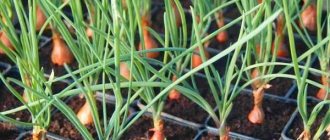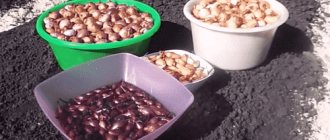The best varieties of watermelons for Siberia
The first step is to choose a watermelon variety that suits the conditions of Siberia. Pay attention to the short growing season, frost resistance, and weight of the berries (up to 5 kg). The main task is to ensure that the fruit has time to ripen. In most cases, varieties are selected that are bred by local breeders and adapted to the Siberian climate. The ultra-early and early varieties Sibiryak, Sugar Baby, Siberian Lights, Northern Lights, Ogonyok, Ultra Early, intended for open ground, meet precisely these requirements.
Table: characteristics of watermelon varieties for open ground
| Variety name | Maturation period | Average weight of berries | Description |
| Ogonyok | 71–87 | 2 kg | The fruit is spherical, thin smooth black-green peel with a blurred pattern, red flesh. |
| Sugar baby | 75–80 | 1 kg | The fruit is spherical, thin green peel with visible black stripes, bright pulp. |
| Sibiryak-97 | 75–82 | 4.5 kg | The fruit is round, a thin dark green rind with almost imperceptible stripes, sweet bright pulp; resistant to sudden temperature changes. |
| Siberian lights | 70–80 | 2.5–3 kg | The fruit is spherical in shape, the peel is thin, dark in color with longitudinal light green stripes, juicy, bright pulp; beautiful presentation, resistance to fusarium. The plant is slightly branched (up to 2.5 m). |
| Northern lights | 65–75 | 2.5 kg | The fruit is spherical, the thin rind is dark green, the scarlet pulp is juicy and sugary. |
| Ultra early | 80 | 4–5 k | The fruit is spherical in shape, granular scarlet pulp, high sugar content, cold resistance. The plant is compact, with moderate branching. |
The watermelon variety Ogonyok is small in size and manages to ripen during the short Siberian summer
Watermelon varieties for the greenhouse
For a greenhouse or temporary film shelters, the most suitable will be early and mid-ripening watermelon hybrids, tested in cold climates and insufficient lighting, which have proven themselves when grown in the northern regions.
Table: characteristics of watermelon varieties for open ground
| Variety name | Maturation period | Average weight of berries | Description |
| F1 Kai | 70–75 days | 7kg | Oval-elongated fruit with a thin dark skin and longitudinal intermittent light green stripes, aromatic raspberry pulp. The plant is long-climbing. |
| F1 Creamstar | 55–60 days | 8–10 kg | The fruit is spherical in shape with alternating light and dark stripes on the peel, delicate red flesh, with high sugar content; high transportability. |
| F1 Crimson Sweet | 67–82 days | 3–4 kg | An oblong fruit with a dark green skin with longitudinal light stripes; there are no transverse veins in the crispy pulp with a honey taste and bright rich color; high immunity to anthracnose and powdery mildew. |
| F1 Gift to the North | 75–85 days | 10 kg | The fruit is spherical, green peel with a darker longitudinal stripe, bright crispy pulp, excellent taste; high transportability, disease resistance. |
| F1Beijing Joy | 85–90 days | 5–8 kg | The fruit is round in shape, with alternating stripes of light and dark green, dense and thick skin, granular red pulp; high transportability, disease resistance. |
| F1 Pannonia | 73–80 days | 3–5 kg | The fruit is spherical, dark, with bright red crispy pulp, excellent taste characteristics, delicate aroma; high productivity, keeping quality and transportability. |
All of these varieties are ideal for greenhouse cultivation in northern regions with short summers and changeable climate. According to reviews from summer residents, the F1 Kai hybrid has recently gained particular popularity, capable of delighting Siberians with its berries with crumbly aromatic pulp not only in the greenhouse, but also in open areas.
The ovaries of the watermelon hybrid F1 Kai have time to ripen in Siberian conditions, even in open areas
Video: review of watermelon varieties for Siberia
Rules for growing melons in open ground
Growing melons and melons in the country is not difficult. The only problem is that watermelons grow well in open ground only in the south. It is very difficult to do this in Siberia.
Choosing a resistant, fast-ripening variety
First of all, preference should be given to early ripening varieties of watermelon. Such a feature as early ripening will allow you to grow the crop before the onset of cold weather.
The following varieties are suitable for growing in Siberia:
- Kholodok is a mid-early berry variety that is suitable for cultivation in cold regions. The growing season is 80-100 days. The fruits reach a weight of up to 4 kilograms, the shape is slightly elongated, oval. The bushes are characterized by long vines growing up to 5 meters.
- Siberian Lights is another mid-early variety, the fruits of which begin to ripen 80-100 days after planting the seeds in open ground. It is immune to Fusarium wilt. The fruits are small, weighing from 1.5 to 2.5 kilograms. The peel is thin, dark green in color. The pulp is sweet and juicy.
- You can plant the Raspberry Sweet variety in open ground. An unpretentious variety that produces yields when grown in unfavorable climates. The fruits are small, up to 1.5 kilograms. The pulp is sweet, sugary.
Despite the fact that the varieties are suitable for growing in open ground, it is preferable to plant watermelons in a greenhouse.
Planting seedlings in open ground
Planting material is planted in open ground at the end of May - early June. The main thing is that the soil warms up to more than 15 degrees. If you plant seeds in cold soil, they will not sprout. The place for planting seedlings should be located in a sunny area. Bushes require a lot of space, so the beds need to be allocated areas at least 3 meters long and wide.
Before planting, you need to dig up the soil and add 4-5 kilograms of rotted manure. It is not advisable to use fresh manure. In addition, you should apply a complex fertilizer that contains minerals. You need to plant watermelon seedlings in open ground in the same way as in a greenhouse. There are no differences in the planting method.
Technology for growing watermelons in open ground, soil selection, formation and careRead
Watering and fertilizing
Particular attention is paid to the formation of a watermelon bush. To maximize yield, trim side shoots regularly.
Only strong and powerful lashes should be left. The main thing is not to touch the central lash.
You need to water the beds in the evening, after sunset. Water the beds every other day. When the inflorescences begin to bloom, stop watering
It is important to ensure that the soil does not become waterlogged
To increase productivity, fertilizing is important. Nitrogen is used as mineral fertilizers. Such fertilizers are necessary to stimulate growth. Urea is sometimes used instead of nitrogen. You also need to add phosphorus and potassium to the soil. Organic fertilizers include manure, yeast infusions, wood ash and bird droppings.
Harvesting berries
Berries begin to be harvested when they reach biological maturity. According to the rules of agricultural technology, ripe watermelons should have a thick rind and a dried stalk. To keep the crop longer, it should be kept in a dark, cool room. But watermelons cannot be stored for more than a month, even if all conditions are met. Especially early ripening varieties. You need to lay a thin layer of straw on the floor, and then lay out the watermelons. Fruits with cracks should be eaten immediately. They will not be stored for long.
Some summer residents store watermelons in trenches, but this method is suitable for those who live in the southern regions. In Siberia, night frosts occur early and can ruin the harvest.
Growing conditions
A guaranteed harvest of watermelons in such difficult climatic conditions can only be achieved using the seedling method, although some gardeners manage to sow the seeds directly into open ground. In abnormal weather, when the height of summer can stun you with a sharp drop in temperature, choosing the second method will be unsuccessful.
The correct choice of time for sowing seeds for seedlings plays an important role: so that it does not outgrow, but at the same time, the ovary has time to ripen in the future.
Note! For watermelon, the most suitable seed material will be seeds no older than a two-year shelf life!
Whether an attempt to grow a ripened berry will be successful largely depends on the length of daylight hours and temperature conditions. Watermelon is a fairly light-loving and heat-loving crop. The plant requires lighting at least 12 hours a day, and has special requirements for heat. The daily temperature at the time of tying the lashes should be within +19°C, and the night temperature should not fall below +15°C. Active growth of seedlings is possible only on well-warmed soil (from +12°C and above).
Another trick of the Siberians is the construction of special “warm” beds, which are prepared in late autumn. The soil at the site of the future warm bed is dug up to 50 cm. Most of the trench is filled with plant debris, peat, manure, and the top is filled with a soil mixture of two parts turf soil, one part humus and sand so that the soil is 20 cm above the soil level. In such a bed in Siberia, even with heavy incessant rains, the melon crop will not get wet.
A warm bed is the most successful way to grow Siberian watermelon
Adequate light and heat, proper pinching and feeding of plants are the main secrets for caring for watermelon in Siberia.
Growing seedlings
To succeed in growing Siberian watermelon, you first need to grow strong seedlings.
When and how to plant seedlings?
Seedlings are planted in open ground in the second half of June. Considering that its age at the time of planting should be at least 25–30 days, sowing should be done in mid-May. If the seedlings are intended for a polycarbonate greenhouse, they can be sown 2 weeks earlier.
Watermelon seeds are purchased in specialized stores to avoid mis-grading. How to prepare them for sowing? Siberians have their own secrets about this. Many people soak the seeds in warm water (50–60°C), adding a growth stimulator (Epin-extra, Zircon). After they have completely cooled, they are disinfected for half an hour in a 1% solution of potassium permanganate and immediately sown.
The substrate for watermelon seedlings should be quite nutritious. To prepare it, take 2 parts of turf and humus, 1 part of sand, 2 tbsp. spoons of dolomite flour and ammonium nitrate and 1 tbsp. spoon of superphosphate, mix well.
The best container for watermelon sprouts is ready-made peat pots. The seedlings are planted in the ground together with them, and their delicate roots are not injured.
In each pot, the diameter of which should be at least 8–9 cm, place 2 seeds “per side”. This way the cotyledon leaves will sprout from the seed faster. Make a 3 cm depression with a spoon, moisten it with water (50 ml) and fill it with dry soil mixture. The containers are covered with glass or plastic film until shoots appear.
Peat pots with sown watermelon seeds are covered with film
Seedling care
Temperature regime for crops: daytime air temperature is at least 25°C and nighttime is not lower than 15°C. In a week, the first shoots will appear, and to prevent the seedlings from stretching, it is advisable to reduce the temperature to 20°C. At the same time, the root system needs more heat, so the containers are kept on the windowsill above the radiators. After five days, you will be pleased with the first real leaf. When 3 such leaves appear, the sprouts can already be fed with complex mineral fertilizer or a solution of bird droppings (1:20). To prevent the nitrogen in the litter from evaporating, it is not infused as usual. After another week, a second feeding is carried out.
Watermelon seedlings in peat cups take root better in open ground
Watering the seedlings should not be excessive; it is enough to water them with warm water 2 times a week. A few days before transplanting, the sprouts are watered daily!
In some cases, lack of light requires additional lighting. So that the seedlings can receive their daily light requirement of 10,000 lux, they are illuminated with fluorescent fluorescent lamps for at least 10 hours a day.
Transplanting seedlings into the ground
Month-old seedlings are planted in open ground, in greenhouse beds or in a greenhouse.
In mid-June, when the threat of late spring frosts has passed, the seedlings are planted on a warm raised bed prepared in the fall. 3 days before planting, it is necessary to harden the sprouts. First, they are taken to a cooler place for 15–20 minutes and every day the time spent at a reduced temperature is increased.
Holes on a warm ridge are prepared in advance, immediately after sowing the seeds. While the seedlings are growing, the soil in them will have time to warm up to the required temperature. The holes are dug at a distance of at least 0.8–1 m from each other, with row spacing of 1.4 m. The recesses should be a couple of centimeters larger than the height of peat or plastic cups. To fill the holes, prepare a soil mixture of two parts humus, one part ash and sand, mix well and moisten. After this, the entire bed is mulched with black plastic film, which will retain moisture longer and reduce temperature changes due to accumulated heat. At the same time, the plants will receive protection from weeds, and the berries will be able to ripen a week earlier.
In place of the holes, cross-shaped slits are made with a diameter equal to the diameter of the pot. Carefully remove the soil, water it generously with warm water, insert a peat pot with seedlings so that it does not protrude above the surface of the soil and fill it with dry soil mixture removed from the hole.
Black film on a watermelon bed retains heat and creates comfortable conditions for seedlings
Plants planted in plastic containers are removed by transshipment, watering well before this procedure. After planting the seedlings, air pockets may form, so you should water them as soon as possible. An intact root system will quickly begin to grow. To better adapt seedlings to open space conditions and protect them from possible cold and wind, cover the beds with non-woven material for 2 weeks.
Planting seeds
As already described, areas for watermelon beds are prepared in the fall, choosing the sunniest and most open places. And in order to prevent the influence of the north wind, they create a curtain of several rows of corn.
In open ground
Watermelon seeds for sowing in open ground are prepared in the same way as for sowing seedlings. They are pickled, washed with water, soaked in a growth stimulator, and then in hot water, wrapped in soft material and kept warm until germination. Make sure that the material is always slightly damp. Germination takes almost a week, but the plant will reward you with friendly and strong shoots, and the harvest can be obtained up to 2 weeks earlier.
Sowing patterns are different, and when choosing them, you need to take into account the characteristics of a particular variety. Watermelon varieties with compact bushes can be planted at a distance of about 6 m from hole to hole and 1 m between rows. Moderately climbing bushes are given a little more space for development: 0.8 cm x 1.2 m, and long-climbing watermelons are sown according to the pattern 1m x 1.5m.
In the last ten days of May, when the soil is sufficiently warmed up, the seeds are sown in high beds or in pre-prepared holes, as is the case with seedlings. If you germinate the seeds before planting, it is enough to put 3-4 seeds in each hole. When planting, use tweezers so as not to damage the fragile hatching bores. The holes are watered with warm water and covered with dry soil on top. The rows are mulched and temporary shelters are installed.
Sprouted watermelon seeds will sprout quickly, and the harvest can be obtained up to 2 weeks earlier
In each hole, 2 strong sprouts are left and the rest are removed. Later, their branches are directed in opposite directions so that they do not intertwine and interfere with each other’s development.
The first feeding can be done with an infused solution of bird droppings (1:20) in the development phase of three true leaves, and later it will be enough to feed with an infusion of weeds 2 times a month. Water the seedlings with warm water 2 times a week.
To the greenhouse
The time for planting watermelon in greenhouse beds depends on the temperature in the greenhouse. In polycarbonate greenhouses, the air warms up to a temperature of + 25⁰C during the day and +15⁰C at night several weeks earlier than in less airtight glass and film greenhouses. In the Siberian regions this happens on the twentieth of May. Preparatory work and planting technology are no different from planting in open ground. Only in greenhouses do plants take up less space due to their cultivation on trellises, so a compact planting scheme of 0.5x0.7 m is used.
When planting seeds, only early ripening varieties of watermelons are selected. To avoid the negative effects of unexpected frosts, crops are covered with paper boxes, plastic bottles, etc.
Experienced melon growers recommend placing opaque plastic bottles of water on the beds. The water heated in them during the day gradually cools down at night, releasing its heat and creating comfortable conditions for plants.
Care
In order not to be left without a harvest when growing watermelons in Siberia, it is necessary to regularly monitor the watermelon beds and provide them with proper care, which varies slightly depending on the place of growth.
In the open ground
It is enough to water plants with mulched soil 2 times a month, taking into account the rare hot days. Along with watering, it is recommended to feed them with a solution of mullein (1:10) or a solution of mineral fertilizer with microelements. Pollination is carried out manually in the middle of the day in dry, windy weather.
Pinching is a must. In most cases, 2 lashes are left and all the stepsons on them are removed. This operation is done weekly, constantly monitoring the appearance of growing side shoots. 2-3 flowers are left on the central stem so that the watermelons are not too large and have time to ripen.
As soon as the ovaries reach a diameter of 5–6 cm, pinch off the top of the shoot, leaving up to 5 leaves after the last green shoot. Future fruits are placed on planks so that they do not touch the wet ground and rot.
Recent Entries
Lilac perennials that are beautiful, compact and do not crowd out other plants Why when buying seedlings you should not take the sellers’ word for it and how to determine the age of the plant using 3 signs Tomato seedlings have turned purple or whitish: why the color has changed and how to save the plants
In the open ground, the row spacing is regularly loosened, and the weeds near the plant itself are carefully picked so as not to harm the delicate roots of the watermelon, which immediately react negatively to even slight damage. In the last phase of the growing season, they stop loosening and try not to trample the soil near the plants.
In July, fertilizing with phosphorus-potassium fertilizer will not hurt. Experienced Siberian melon growers stop watering 5 days before harvest, although many sources recommend not watering watermelons for a whole month before harvest. This should not be allowed, especially in hot weather. There is a misconception that watering contributes to the development of wateriness. Watermelon is not as drought-resistant as many people think. Without water, its fruits become smaller and tasteless. Of course, watering in Siberia is regulated by the weather. It happens that plantings have to be covered with film during prolonged rains.
Bricks are placed under the filling fruits, accumulating heat during the day and gradually releasing it at night, smoothing out the difference in daily temperatures.
Watermelons fill faster on bricks
Once a week, the berries are carefully turned over so that each side of the fruit gets plenty of sunlight and warmth.
Video: how to grow watermelon in open ground in Siberia
In the greenhouse
In most cases, watermelon in a greenhouse is grown on a trellis to save space.
On hot days, the air in the greenhouse should not be allowed to overheat (above + 30 ⁰C), so it is regularly ventilated by opening the windows and doorways. Watering is carried out only with warm water over the entire area of the bed, while avoiding water getting on the plants.
Until female flowers appear on the watermelon plant, it is enough to water them 3-4 times a week. Pollination is carried out mechanically: each pistil of a female flower is pollinated manually with pollen from a male flower. At the end of the petiole under the female specimen there is a small thickening - a miniature fruit that is easy to notice and distinguish flowers. Artificial pollination is carried out during the day, when the flower is well open and dry. They do this quickly and several times. In order for the fruits to develop normally, after pollination, watering is increased to 2 times a week. Fertilizing is also combined with watering: at the beginning of the growing season, they are fed with nitrogen fertilizer, and a month before harvesting, with phosphorus-potassium fertilizer.
When the lashes reach 2 meters, the bush is formed by pinching the tops and removing the stepsons. Siberians already know from their experience of growing watermelon that in a greenhouse it is better to leave only one central shoot with one strong ovary.
Video: how to grow a greenhouse watermelon in Siberia
When the ovaries begin to weigh down the whip, they must be tied up with ropes, nets, using string bags, old nylon tights, etc. Thanks to this, the fruits are held on the trellis and are evenly illuminated.
Advice from experienced farmers
Those who have decided to grow sweet fruits on their plot for the first time will benefit from the advice of experienced farmers:
- For planting, choose a well-lit place, warmed by the sun throughout the day. Lack of sunlight will negatively affect the taste of the fruit - watermelons will be unsweetened. The accumulation of sugars directly depends on the intensity of photosynthesis.
- Plants should not be planted densely; bushes should be ventilated.
- Watermelon beds are watered moderately. Excessive moisture leads to the spread of root rot.
- The planting site is dug up in the fall and rotted manure is added. This will make it easier for the plant’s roots to penetrate into the deeper layers of the soil.
- The ideal option is to sow the area for watermelons in advance (1-2 years before planting) with winter wheat, perennial grasses, corn and dig them up at the stage of young plants, embedding them in the soil.
Diseases and pests
The Siberian summer does not offer good weather. As a rule, in the second half of July there are sharp cold snaps and prolonged rains. The harsh climate becomes favorable for diseases and harmful insects of watermelon.
Diseases
Watermelons in open ground especially suffer from extreme climates, since dampness is an excellent environment for the development of many diseases. Most often, watermelon plants are affected by anthracnose, bacteriosis, powdery mildew, and Fusarium wilt.
Anthracnose
Anthracnose is a disease that causes the greatest damage to the watermelon crop.
The manifestation of this disease is easy to notice on the leaves: they are all covered with yellow spots, which later turn brown and dry out. Leaves damaged by the fungus fall off, and weakened stems become fragile and quickly break. The deformed ovary stops developing. A melon plant with completely mutilated plants and rotten fruits is an eerie picture of the dangerous “artist” anthracnose.
Anthracnose of the fetus begins with rotting of individual areas on which ulcers form
The pathogen is found in seeds, plant debris, in the soil, and infects more and more new plants, spreading by rain and wind, insects, and also due to careless watering.
The melon grower should adjust watering, provide ventilation, pay attention to the density of plantings, regularly inspect the melons and remove diseased plants. If signs of anthracnose are detected, crops are saved by dusting them with sulfur.
Fusarium
Fusarium is no less dangerous for watermelon. The pathogen can remain in the seeds and soil for about 5 years, so the root system and base of the watermelon stem are always the first to suffer. From the root, the infection spreads to all parts of the plant.
The first victims of fusarium are the root system and the base of the stem
Due to the accumulation of toxins released by the fungus, the plant's vascular system is paralyzed, inhibiting its growth. Often, infection with a fungus occurs in wet weather, when the soil temperature drops to 16 °C or lower, as well as through non-compliance with agrotechnical rules.
Fusarium wilt is often observed in seedlings. You should be extremely careful and promptly discard disease-affected sprouts. Fusarium can be avoided if you properly care for your crops: treat the seeds, observe crop rotation, loosen the rows, and do the necessary fertilizing. Diseased bushes are destroyed and the leaves of the remaining plants are fed with potassium-phosphorus fertilizer (5 g/10 l).
Powdery mildew
The disease is manifested by the appearance of powdery coatings on the foliage and vines of watermelon. Its pathogen quietly overwinters on the remaining plant debris, and in the spring it begins to attack the plant. The spread of the disease can occur even in dry weather but heavy dew.
Powdery coatings appear on the leaves and stems of the watermelon plant.
The leaves dry out, become deformed, and in the fall, instead of whitish coatings, fungal fruiting bodies appear in the form of black dots - sources of spring infection. Affected plants exhibit low fruit set, and the berries themselves become unsweetened and low in juiciness.
Having discovered a disease, the plantings are watered with a solution of colloidal sulfur (50g/10l), which is harmless to pollinating insects.
Disease Prevention
Of course, the best prevention of watermelon diseases is proper care for them. Seeds are disinfected before planting, the rows are mulched with chalk or ash, and efforts are made to prevent excessive soil moisture. Rotten fruits are immediately isolated from healthy ones, and their seeds are not used for sowing. The remains of diseased plants must be burned.
In the conditions of the North, melon growers use preventive spraying of watermelon plantings against many fungal infections with fungicides Fundazol, Oksikhom (20g/10 l).
Note! Spraying with systemic-contact preparations is carried out in the evening no more than 20 days before the watermelon harvest.
Pests
The most common pests of watermelon in Siberia are wireworms and melon aphids.
Wireworms
Unpleasant, hard, yellow-brown worms are the larvae of wireworms, which cause great harm to plants by gnawing the root system. They can be found in the ground, under a withering bush. Click beetles and their larvae love to huddle in perennial weeds. Therefore, by destroying weeds, you can also get rid of wireworms.
Note! In order to prevent wireworms, many gardeners scatter fallen nut leaves over the area, the smell of which these pests cannot tolerate.
Beetles and their larvae
melon aphid
Aphids live and lay eggs on wild grasses, and in early summer they move to watermelons. It is dangerous as a carrier of viruses and a direct pest, sucking juices from the leaves, stems, flowers and ovaries of watermelon plants. Whole hordes of aphids settling on the underside of the leaves can be seen by the leaves curling into a tube and drying out. If insects are not controlled, they produce more than a dozen generations during the growing season. It is important not to miss the first invasion of melon aphids, when they can simply be washed off with water.
Aphids occupy the underside of watermelon leaves
The rows are regularly weeded, the plants are dusted with ash, tobacco dust, and treated with infusions of garlic and onion peels. They fight with the aphid's companions, the ants that feed on the sticky secretions of the aphids and spread their larvae with their paws. In the Siberian climate, insecticides are rarely used in open areas, since frequent rains and cool weather prevent the development of aphids.
Harvesting
The watermelon harvest begins in August. Keep in mind that early ripening varieties are not intended for long-term storage. All fruits will have to be eaten soon or used for canning. The collected fruits of early varieties are stored for no more than 1.5 weeks.
Watermelons are removed from the garden as they ripen. Fruits from one plant are collected in 2-3 doses. Pumpkins are cut using a sharp knife or garden shears. It is undesirable to tear off the stalk with your hands - this leads to rotting of the fruit in this place.
The ripeness of watermelons is determined by their appearance. In a ripe fruit, the stalk, tendrils and leaves near the fruit dry out. This is a universal sign of ripeness for all pumpkin crops. In addition, when you tap the watermelon with your fingers, a dull, low sound is heard.











